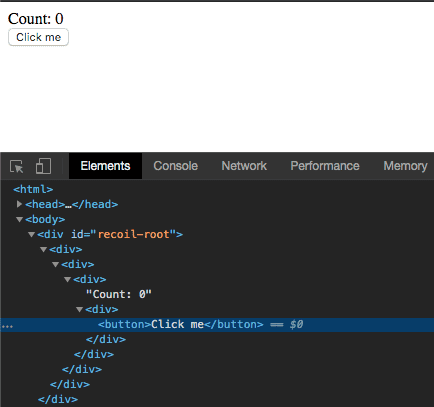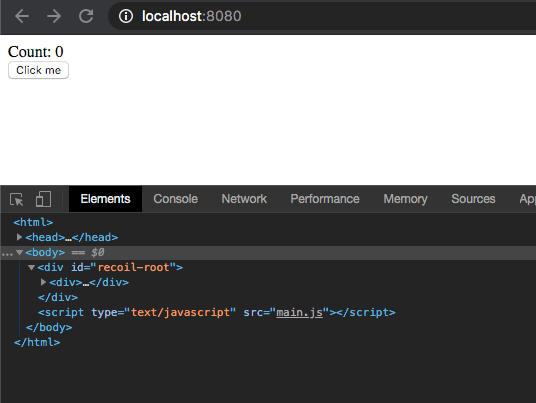React hooks from scratch
This is my third post in a series where I document my development of recoil, a React clone built from scratch for learning purposes.
My last post added support for creating stock HTML elements (divs) as well as custom components.
We did this with a simple createElement method that would call a provided render function. The render function returned either a string directly or it called other createElement functions which ultimately returned a string themselves. Then we created a function component called DivComponent to handle <div> creation, and one called GreetingComponent to test custom component creation.
The code looked like:
function createElement(component, props = {}) {
// String "component", so just return the string. Like a text node in HTML
if (typeof component === "string") {
return component
}
// 'render' the component
return component(props)
}
function DivComponent({ children, ...otherProps }) {
// Turn each child into a string of HTML
let processedChildren = (children || []).map(child =>
createElement(child, otherProps)
)
// Wrap the html string of the children in the div tags
return `<div>${processedChildren.join("\n")}</div>`
}
function GreetingComponent({ name }) {
return createElement(DivComponent, {
children: [createElement(`Hello ${name}`)],
})
}Recoil only supports functional components, so the next step is to give the functional components the ability actually do something by implementing React Hooks. The biggest change here is that somehow state must persist across renders.
Data structure for persisting state
My method for persisting state is to build a Wrapper class around the functional component. This class will store the state as an instance variable, so that subsequent calls to render() can access it.
Then we can build a a tree structure of these Wrapper classes that represent the app and its components. This way we can re-trigger the render() call on the component whenever our hooks are called.
class Wrapper {
constructor(renderFunc, props) {
this.renderFunc = renderFunc
this.props = props
}
render() {
// TODO: Figure out how to create and manage state
return this.renderFunc(this.props)
}
}At this point, we should also split the HTML string generation from the component rendering to keep things simple. We can update createElement to only return Wrappers rather than strings or functions.
function createElement(renderFuncOrString, props) {
// Only return Wrappers now
if (typeof renderFuncOrString === "string") {
return new Wrapper(() => renderFuncOrString, props)
}
return new Wrapper(renderFuncOrString, props)
}Now that we know everything is a Wrapper, we can create another function that converts the Wrapper to HTML. We’ll call this function buildDOM.
Let’s also use the proper browser API to generate HTML elements rather than manually building the opening and closing tags as strings. Eventually we will want to add HTML attribute props like style and onClick, it’s going to be really messy to do the string manipulation ourselves. So we’ll use document.createElement and document.createTextNode instead.
function buildDOM(wrapper) {
var element = document.createElement(/* TODO: Which HTML tag do we use? */)
// The result of a render call will either be a string or another wrapper
var stringOrWrapper = wrapper.render()
const childrenType = typeof stringOrWrapper
if (childrenType === "string") {
element = document.createTextNode(stringOrWrapper)
} else if (childrenType === "object") {
// Simplest to always treat the child components in the render() call as an array
let childWrappers = Array.isArray(stringOrWrapper)
? stringOrWrapper
: [stringOrWrapper]
childWrappers.map(child => element.appendChild(buildDOM(child)))
} else {
throw Error(`Unknown component type: ${typeof stringOrWrapper}`)
}
return element
}The first problem we have is that we haven’t specified what how a Wrapper will be represented in HTML. For example, given this React JSX example:
<MyComponent>Hello</MyComponent>What does <MyComponent> actually become in the DOM? Since you can have onClick handlers on custom components, that means that it must be some element in the DOM. In recoil, I’ll just consider custom components to be <div> elements for now.
Since Wrappers handle both custom components and actual HTML elements, we need to store the HTML tag that each Wrapper corresponds to for the latter case. Let’s update our class definition and include a default tagName of null so that we can tell the difference between a custom component and div. We also need to update our createElement method to take the tag name, as well as plugging in the tag into buildDOM:
class Wrapper {
constructor(renderFunc, props = { children: [] }, tagName = null) {
this.renderFunc = renderFunc
this.props = props
this.tagName = tagName
}
render() {
// TODO: Figure out how to create and manage state
return this.renderFunc(this.props)
}
}
function createElement(renderFuncOrString, props, tagName = null) {
if (typeof renderFuncOrString === "string") {
return new Wrapper(() => renderFuncOrString, props, null)
}
return new Wrapper(renderFuncOrString, props, tagName)
}
function buildDOM(wrapper) {
var element = document.createElement(wrapper.tagName || "div")
var stringOrWrapper = wrapper.render()
const childrenType = typeof stringOrWrapper
if (childrenType === "string") {
element = document.createTextNode(stringOrWrapper)
} else if (childrenType === "object") {
let childWrappers = Array.isArray(stringOrWrapper)
? stringOrWrapper
: [stringOrWrapper]
childWrappers.map(child => element.appendChild(buildDOM(child)))
} else {
throw Error(`Unknown component type: ${typeof stringOrWrapper}`)
}
return element
}We still don’t have hooks yet. But we have components that can theoretically persist across renders.
Let’s build a basic, non-functioning counter app to prepare for implementing hooks. First we will create a CounterComponent contains a button and some text:
// The recoil version of a <button> JSX tag
function ButtonComponent({ children = [], ...otherProps }) {
return createElement(() => children, otherProps, "button")
}
// Simple custom component. Count is hardcoded to 0
function CounterComponent() {
const count = 0
return [
createElement(`Count: ${count}`),
createElement(ButtonComponent, { children: [createElement("Click me")] }),
]
}Then we generate the HTML and insert it into the DOM so we can actually see it:
const app = createElement(CounterComponent)
const rootElement = document.getElementById("recoil-root")
rootElement.innerHTML = ""
rootElement.appendChild(buildDOM(app))

Now we have at least 3 more things to do:
- Come up with our own implementation of React’s useState function.
- Bind the
onClickprop to theonclickattribute of the<button> - Trigger a re-render when the component state changes
For this version, we will re-render the entire app when any component’s state changes.
Implementing useState
useState in React is interesting because it only takes the initial value of the state as an argument. It doesn’t take a this instance, yet it knows how to look up the state for this particular component, and provides a setter function to update this piece of state.
First I tried to explore the ways to detect the caller of a function in Javascript, but this seemed like a huge hack with poor cross-browser support.
Then I realized that since Javascript functions are also objects, I could just use regular object properties to set the relevant state fields on the useState function just before Wrapper.render() calls the components render function. Something like:
For example:
function useState(defaultState) {
// Need to implement the real logic, but we do have access to state here
console.log(useState.state)
}
class Wrapper {
[...]
render()
[...]
// Persist the component's state by putting the last state values into the function object
useState.state = LAST_STATE
return this.renderFunc(this.props)
}Since useState doesn’t take a variable name as an argument, we must rely on the order of the useState calls to know which piece of state we want to retrieve.
For example, in React components that are built with classes, you can use this.state.count to access the count variable inside of state. With functional components and hooks, the return value of useState includes the value directly, without a name, like:
const [count, setCount] = useState(0)
const [name, setName] = useState(null)So in this case, our Wrapper must know remember that the first call to useState corresponds to the count variable, and the second call to useState corresponds to name.
With that in mind, let’s build our useState function and update our Wrapper class:
function useState(defaultVal) {
const { curStateIndex, states } = useState.stateInfo
useState.stateInfo.curStateIndex += 1
if (curStateIndex > states.length - 1) {
useState.stateInfo.states.push(defaultVal)
}
// Return the current value for this piece of state,
// and the setter so that the component can update it
return [
states[curStateIndex],
newVal => {
states[curStateIndex] = newVal
},
]
}
class Wrapper {
constructor(renderFunc, props = { children: [] }, tagName = null) {
this.renderFunc = renderFunc
this.props = props
this.tagName = tagName
// Set the initial state list to be empty
this.states = []
}
render() {
// Reset the current state index before each render
useState.stateInfo = {
curStateIndex: 0,
states: this.states,
}
// Returns wrappers
return this.renderFunc(this.props)
}
}Now we have a simple implementation of the useState hook. But since we don’t have the ability to re-render our components, we can’t actually use it yet.
Component re-rendering
To re-render components, we need a loop that checks if there are any changes that should trigger a re-render. React aims to support rendering of up to 60 FPS. In order to re-render up to 60 times per second, they need to divide that 1 second into 60 frames. 1 sec / 60 frames = 0.0166667 seconds per frame, or 16 about milliseconds. This means that React has a loop that checks for component changes up to once every 16 milliseconds.
Since we’re just getting started, I would prefer to have a slower loop in case I make any mistakes in my re-rendering algorithm. Let’s go with 100 milliseconds per event loop call.
We’ll also create a global variable called NEEDS_TO_RENDER that will be set to true if either useState() or a setter in useState() is called.
function eventLoop() {
if (NEEDS_TO_RENDER) {
console.log("RENDERED")
const rootElement = document.getElementById("recoil-root")
rootElement.innerHTML = ""
rootElement.appendChild(buildDOM(app))
NEEDS_TO_RENDER = false
}
}
setInterval(eventLoop, 100)The updated useState():
function useState(defaultVal) {
NEEDS_TO_RENDER = true
const { curStateIndex, states } = useState.stateInfo
useState.stateInfo.curStateIndex += 1
if (curStateIndex > states.length - 1) {
useState.stateInfo.states.push(defaultVal)
}
return [
states[curStateIndex],
newVal => {
states[curStateIndex] = newVal
NEEDS_TO_RENDER = true
},
]
}onClick handler
Now that we have re-rendering built, we can finally hook in the onClick handler to complete our counter app.
First let’s update our CounterComponent to pass an onClick prop and use our new useState method.
function CounterComponent() {
const [count, setCount] = useState(0)
return [
createElement(`Count: ${count}`),
createElement(ButtonComponent, {
children: [createElement("Click me")],
// onClick handler that uses the React hook setter
onClick: () => {
setCount(count + 1)
},
}),
]
}Then we need to update the function that converts our Wrappers into HTML strings to connect this to the onclick HTML attribute.
function buildDOM(wrapper) {
var element = document.createElement(wrapper.tagName || "div")
var stringOrWrapper = wrapper.render()
const childrenType = typeof stringOrWrapper
// Added a simple check for the onClick handler.
// For now only accept onClick handlers of the wrapper is a regular HTML component
if (wrapper.tagName && wrapper.props.onClick) {
element.onclick = wrapper.props.onClick
}
if (childrenType === "string") {
element = document.createTextNode(stringOrWrapper)
} else if (childrenType === "object") {
let childWrappers = Array.isArray(stringOrWrapper)
? stringOrWrapper
: [stringOrWrapper]
childWrappers.map(child => element.appendChild(buildDOM(child)))
} else {
throw Error(`Unknown component type: ${typeof stringOrWrapper}`)
}
return element
}After connecting everything described above, we have a very simple and functional React hooks implementation in recoil!

The full code for this implementation can be found on github.
Next time we’ll improve recoil so that it only re-renders components that have changed, rather than re-rendering the whole app every time.
Let me know what you think on twitter:
I built #reactjs hooks from scratch in my own framework as a learning exercise. Next up will be smarter component re-rendering.https://t.co/j5l7HhbN7R
— Vedran Budimcic (@vbudimcic) February 8, 2020